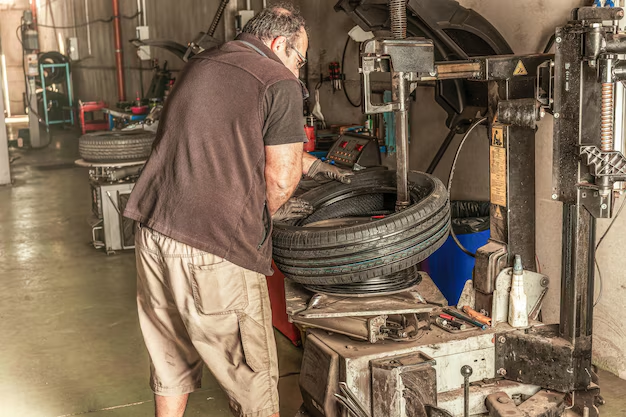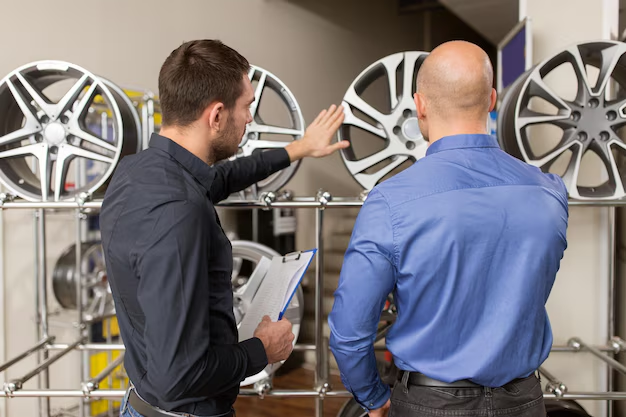If you’re a car owner in Barrie or the surrounding areas, you’ve probably heard the terms “tire rotation” and “wheel alignment” thrown around during your regular car maintenance visits. But do you know what they really mean and why they are so important for your vehicle’s health?
In this guide, we’ll delve into the differences between tire rotation and alignment, explain why each process is important, and how they can save you time, money, and a significant amount of hassle down the road.
Understanding Tire Rotation
Tire rotation is a crucial aspect of regular vehicle maintenance that often gets overlooked. But what exactly does it entail?
What is Tire Rotation?
Tire rotation involves moving the tires from one position on the vehicle to another. This could mean switching the front tires to the back and vice versa, or even moving them diagonally. The goal is to ensure that all tires wear evenly over time. Uneven tire wear can lead to reduced traction, less efficient fuel consumption, and ultimately, the need for premature tire replacement.
Picture your car as a pair of shoes. Wearing the same pair day after day results in certain areas wearing out faster than others. Rotating your tires is like switching shoes – it helps distribute the wear evenly, so no single tire bears the brunt of the road alone.
Why Tire Rotation is Important
Rotating your tires regularly helps extend their lifespan. Tires tend to wear unevenly due to factors like weight distribution and road conditions. For instance, the front tires in front-wheel-drive vehicles often wear out faster because they handle more weight and are responsible for steering. Regular rotation helps balance out this wear and tear, providing a smoother ride and improving safety on the road.
Consider a practical example: driving through Barrie’s snowy winters. Your front tires, tasked with steering and handling the weight of the engine, are more prone to wear down. By rotating them, you ensure they don’t get bald prematurely, which could lead to dangerous situations on icy roads.
How Often Should You Rotate Your Tires?
The general recommendation is to rotate your tires every 5,000 to 8,000 kilometers. However, this can vary depending on your vehicle’s make, model, and your driving habits. Always check your vehicle’s owner’s manual for specific guidance. Additionally, some service providers offer packages where tire rotation is included during routine oil changes, making it convenient to keep up with this essential maintenance.
Preventative maintenance is key here. By sticking to a regular rotation schedule, you can avoid costly replacements. A new set of tires might cost anywhere from $400 to $1,000, depending on your vehicle’s size and the tire brand. In contrast, a rotation service is relatively inexpensive, often ranging from $20 to $50.
Delving into Wheel Alignment
While tire rotation focuses on the tires themselves, wheel alignment deals with the vehicle’s suspension system. Let’s explore this further.
What is Wheel Alignment?
Wheel alignment refers to the adjustment of the angles of the wheels to ensure they are perpendicular to the ground and parallel to each other. Proper alignment involves adjusting the camber, caster, and toe angles of the wheels. This is crucial for maintaining consistent handling and optimal tire contact with the road.
Think of wheel alignment as the choreography of a dance troupe. If one dancer is out of sync, the whole performance suffers. Similarly, if one wheel is misaligned, it affects the entire vehicle’s performance and safety.
The Importance of Wheel Alignment
Misaligned wheels can lead to a host of problems, including uneven tire wear, steering difficulties, and increased fuel consumption. If your vehicle drifts to one side or the steering wheel vibrates, it might be time for an alignment check. Correct wheel alignment not only enhances vehicle performance but also improves safety by ensuring that your car handles properly.
Imagine driving down Barrie’s Highway 400, and your car keeps veering to the right. Not only is this annoying, but it can also be dangerous. Proper alignment ensures your vehicle tracks straight, making your drives safer and less tiring.
Signs You Need a Wheel Alignment
Several indicators suggest your car might need an alignment. These include uneven tire wear, pulling to one side, a crooked steering wheel when driving straight, and any vibrations felt in the steering wheel. If you notice any of these signs, it’s wise to seek professional wheel alignment services.
Ignoring these signs can lead to bigger issues. Misalignment can cause tires to wear out faster, leading to premature replacement costs. Alignments typically range from $75 to $100 per service, a small price compared to the expense of replacing tires more frequently.
Tire Rotation vs. Alignment: Key Differences
Both tire rotation and wheel alignment are vital, but they serve different purposes.
Distinct Functions
Tire rotation is about repositioning tires to promote even wear, whereas wheel alignment focuses on adjusting the suspension for optimal wheel angles. While rotation can often be done at home or during a regular service, alignment requires specialized equipment and expertise.
To visualize the difference, think of tire rotation as rearranging your furniture to ensure even wear on your carpet, while alignment is like adjusting the foundation of your house to keep it level.
Impact on Vehicle Performance
While both services contribute to extending tire life, wheel alignment has a more direct impact on vehicle handling and safety. Misalignment can lead to more serious issues if left unchecked, such as rapid tire wear or steering problems.
Proper alignment ensures that your vehicle handles smoothly, much like a well-tuned instrument plays beautifully. Neglecting alignment can result in a bumpy, inefficient ride, akin to an out-of-tune piano.
Cost Comparison
Typically, tire rotation is less expensive than wheel alignment since it requires less labor and equipment. However, investing in both services as needed can save you more in the long run by preventing premature tire replacement and improving fuel efficiency.
Consider this: you might save $100 by skipping an alignment, but this could cost you an extra $400 in premature tire wear. Regular maintenance is an investment in your vehicle’s future.
Seasonal Considerations for Tire Care
Winter Tires and Rotation
In Barrie, where winter conditions can be harsh, switching to winter tires is a common practice. It’s also crucial to rotate these tires to ensure even wear and maintain grip on icy roads.
Winter tires offer improved traction on snow and ice, but they can wear unevenly if not properly rotated. Rotating them ensures consistent performance, much like rotating your wardrobe to keep your clothes in good condition.
Summer Drives and Alignment
During warmer months, summer road trips can put extra strain on your vehicle. Ensuring your wheels are aligned before hitting the road can help prevent unexpected issues and improve fuel economy.
Imagine heading out on a summer drive to Wasaga Beach, only to have your car pull to one side. Ensuring proper alignment before such trips can save you from unpleasant surprises.
Local Expertise in Barrie
Choosing the right service provider for your vehicle’s maintenance is crucial. Auto Tech Solutions Inc, located in Barrie, offers expert wheel alignment services and tire rotation to keep your vehicle running smoothly.
Ensuring Optimal Vehicle Health
Both tire rotation and wheel alignment are integral to maintaining your vehicle’s health. Regular maintenance ensures that you enjoy a safe and comfortable driving experience, while also maximizing the lifespan of your tires and improving fuel efficiency.
Think your car might need a check-up? Contact Auto Tech Solutions Inc today to schedule your next wheel alignment or tire rotation service. Our team of experts is here to help you keep your vehicle in top shape. Remember, regular maintenance is not just an expense; it’s an investment in your vehicle’s longevity and your safety on the road.


